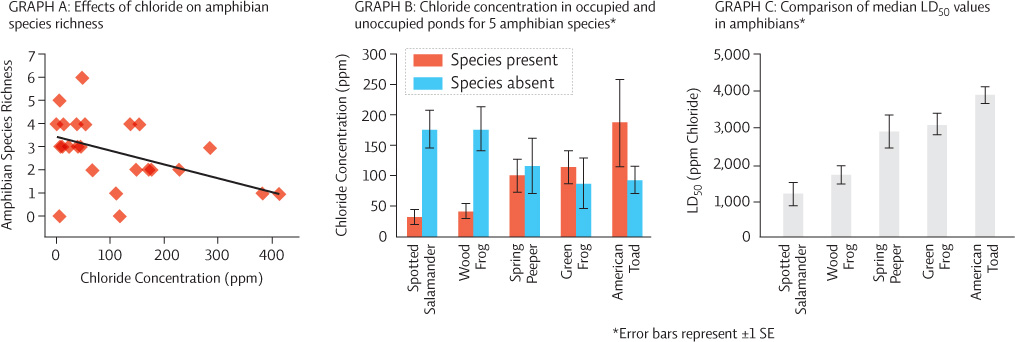SCIENCE LITERACY WORKING WITH DATA
The application of road salt in cold climates can result in runoff pollution that can damage aquatic ecosystems. Researchers at Saint Mary’s University in Halifax surveyed local roadside ponds (some of which were occupied by amphibians and some of which were not) to determine chloride concentration and species richness of amphibians. They also investigated the vulnerability of five amphibian species to sodium chloride (NaCl) by determining the LD50, the dose or concentration of chloride that kills 50% of the population.

Interpretation
1. Look at Graph A above. In a single sentence, explain the relationship between chloride concentration and species richness.
As chloride concentration in the ponds increases, amphibian species richness declines.
2. Look at Graph B. Which species of amphibian is least affected by the presence of chloride in the water? Explain your reasoning.
The American Toad appears to be the least sensitive to chloride. Ponds with as much as about 180 ppm chloride, still had American toads present. All the other species were found at much lower chloride concentrations, suggesting that they cannot tolerate higher levels of chloride.
3. Look at Graph C. Which species is the most sensitive to chloride? Which is the least sensitive?
Spotted salamanders are the most sensitive to chloride based on the LD-50 test — it takes a lower dose of chloride to kill half the population than any of the other species test. American toads are the least sensitive with the highest LD-50.
Advance Your Thinking
4. Look at Graph B and Graph C. Does the LD50 for each species shown in Graph C correlate with the data (presence or absence of each species according to chloride concentration) shown in Graph B? Explain.
These data do correlate. Salamanders have the lowest LD-50 and are also only found in ponds with low chloride concentrations. The LD-50 data indicates that they are more sensitive to chloride than the other species and this is a likely reason they are absent from high chloride ponds. It is interesting to note that they are absent from ponds with chloride concentrations well below the LD-50, further indication that they are extremely sensitive to the presence of chloride.
5. Suggest two actions that could be taken to reduce the chance that road salt would enter ponds in runoff.
• Planting vegetative buffer zones between the roadway runoff zones and the ponds could help trap runoff and prevent it from reaching the ponds.
• Avoid applying road salt to roads close to ponds.